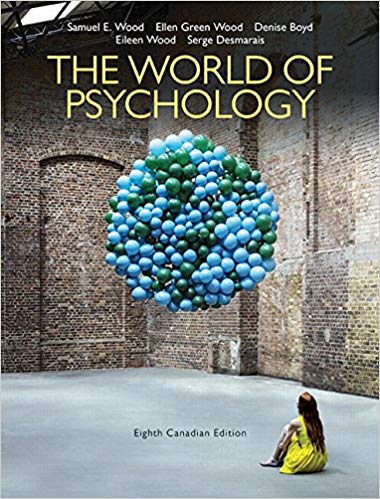Description
The World of Psychology 8th Canadian Edition By Samuel E. Wood – Test Bank
Table of Contents
1 Introduction to Psychology
2 Biology and Behaviour
3 Sensation and Perception
4 States of Consciousness
5 Learning
6 Memory
7 Cognition, Language, and Intelligence
8 Development
9 Motivation and Emotion
10 Social Psychology
11 Personality Theory and Assessment
12 Health and Stress
13 Psyological Disorders
14 Therapies
Test Bank to accompany The World of Psychology, Eighth Canadian Edition
Chapter 3 – Sensation and Perception
1) The process through which the senses detect sensory stimuli and transmit them to the brain is called
a. perception.
b. reception.
c. consciousness.
d. sensation.
Answer: d
Correct: The process of sensing and transmitting sensory information to the brain is called sensation.
Diff: 1
Type: MC
Page Reference: 62
Topic: Factual
Objective: 3.1 Identify and understand the difference between sensation and perception.
2) “The information brought to us by our various senses” is a description of
a. sensation.
b. reception.
c. perception.
d. transduction.
Answer: a
Correct: The process of sensing and transmitting sensory information to the brain is called sensation.
Diff: 1
Type: MC
Page Reference: 62
Topic: Factual
Objective: 3.1 Identify and understand the difference between sensation and perception.
3) Sensory information is organized and interpreted by the brain through the process of
a. transduction.
b. consciousness.
c. perception.
d. sensation.
Answer: c
Correct: Perception is the process of organizing and interpreting sensory information in the brain.
Diff: 1
Type: MC
Page Reference: 62
Topic: Conceptual
Objective: 3.1 Identify and understand the difference between sensation and perception.
4) The process through which we interpret and organize information brought to us by our various senses is called
a. sensation.
b. somnambulism.
c. convergence.
d. perception.
Answer: d
Correct: Perception is the process of organizing and interpreting sensory information in the brain.
Diff: 1
Type: MC
Page Reference: 62
Topic: Factual
Objective: 3.1 Identify and understand the difference between sensation and perception.
5) ________ furnishes the raw material of sensory experience; ________ provides the finished product.
a. Perception; sensation
b. Perception; transduction
c. Sensation; perception
d. Sensation; transduction
Answer: c
Correct: The process of sensing and transmitting sensory information to the brain is called sensation, while perception is the process of organizing and interpreting sensory information in the brain.
Diff: 2
Type: MC
Page Reference: 62
Topic: Conceptual
Objective: 3.1 Identify and understand the difference between sensation and perception.
6) Tina was walking through the woods, and she saw something moving. When she came closer to it, she realized the movement was a deer. Being able to identify the animal was a product of
a. convergence.
b. perception.
c. reception.
d. aphasia.
Answer: b
Correct: Perception is the process of organizing and interpreting sensory information, such as labelling a visual stimulus.
Diff: 2
Type: MC
Page Reference: 62
Topic: Applied
Objective: 3.1 Identify and understand the difference between sensation and perception.
7) Which of the following is listed in your textbook as a “secondary sense?”
a. smell
b. vision
c. balance
d. touch
Answer: c
Correct: Balance and pain are considered two secondary senses.
Diff: 2
Type: MC
Page Reference: 62
Topic: Factual
Objective: 3.1 Identify and understand the difference between sensation and perception.
8) Detecting a candle 48 kilometres away on a clear, dark night, and tasting a teaspoon of sugar dissolved in 9 litres of water are examples of
a. absolute thresholds.
b. difference thresholds.
c. perceptual constancies.
d. transduction.
Answer: a
Correct: The absolute threshold for any given sense is the minimum measure of stimulus that can be detected 50 percent of the time.
Diff: 2
Type: MC
Page Reference: 62
Topic: Factual
Objective: 3.2 Define and explain each of the following measures of the senses: absolute threshold, difference threshold, and signal detection theory.
9) According to its definition, the absolute threshold is the minimum amount of sensory stimulation that a person can
a. detect at least once in ten trials.
b. never detect.
c. detect 50 percent of the time.
d. always detect.
Answer: c
Correct: The absolute threshold for any given sense is the minimum measure of stimulus that can be detected 50 percent of the time.
Diff: 2
Type: MC
Page Reference: 62
Topic: Factual
Objective: 3.2 Define and explain each of the following measures of the senses: absolute threshold, difference threshold, and signal detection theory.
10) The minimum amount of physical stimulation necessary for us to experience a sensation 50 percent of the time is called the
a. blind spot.
b. difference threshold.
c. figure to ground ratio.
d. absolute threshold.
Answer: d
Correct: The absolute threshold for any given sense is the minimum measure of stimulus that can be detected 50 percent of the time.
Diff: 2
Type: MC
Page Reference: 62
Topic: Factual
Objective: 3.2 Define and explain each of the following measures of the senses: absolute threshold, difference threshold, and signal detection theory.





Be the first to review “The World of Psychology 8th Canadian Edition By Samuel E. Wood – Test Bank”